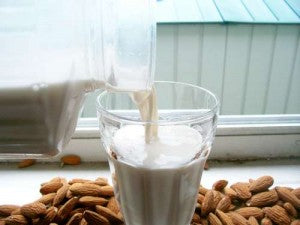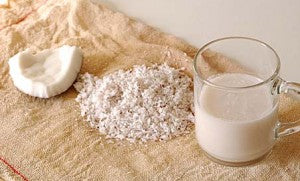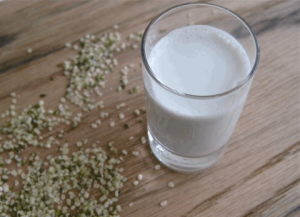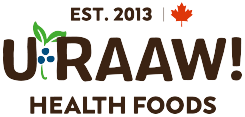As it continues to become apparent that pasteurized cow’s milk may be detrimental to our health, more people are turning to plant derived milk alternatives such as almond, coconut, hemp, oat, or rice milk etc.
Health food stores are no longer the only option when it comes to sourcing these types of beverages. As demand for these products has increased substantially over the past few years, they are now stocked in most Canadian grocery stores.
If you are more of the “do-it-yourselfer” type or like to experiment in the kitchen, consider making your own beverages at home (the steps to make your own beverages are outlined further down in this article).
Now, let’s take a look at three of our favourite milk alternatives you can make from home!
#1 – Almond Milk
Almond milk is a nutrient rich alternative to cow’s milk that is made with ground almonds and water. It is low in calories, and quite mild tasting. Commercial brands can be found at most grocery stores, or you can make your own almond milk at home.
How it tastes:
From www.thekitchn.com
“Almond milk tastes like the milk at the bottom of your cereal bowl after eating Grape Nuts.
Specific, I know. But it has a hint of sweetness, obviously a little nuttiness, and no matter how long it has been in the refrigerator, it doesn’t seem as cold as cow’s milk. As weird as it sounds, it just tastes the tiniest bit warm.
Because almond milk is made from ground almonds mixed with water, there is a watered-down quality to it. But it’s still got body. In fact, as a lover of cow’s milk, I might rank this higher than grey, flimsy skim milk. Compared to 2 percent, though, I’ll take cow.”
Benefits:
- Vegan
- Neutral taste
- Casein, gluten and lactose free
- Contains antioxidants and many vitamins / minerals
- Low carb
Drawbacks:
- Not suitable for those with tree nut allergies
- Some brands contain preservatives such as tapioca starch and sunflower lecithin
What to look out for: Many of the flavoured commercial varieties have cane sugar added, so it’s best to stick to natural / unsweetened or better yet make your own.
How to Make Your Own Almond Milk
You can make your own almond milk with a high powered blender by following the steps below:
Ingredients required: 1 cup raw organic almonds, two cups of water, sweetener (optional).
Kitchen utensils required: Measuring cups, strainer, bowl, blender cheese cloth or nut bag.
Step 1 – Soak 1 cup of almonds for approximately 48 hours. The key to a creamy, fuller milk is ensuring that the almonds soak long enough.
Step 2 – Rinse almonds under tap water to remove phytic acid.
Step 3 – Add almonds and 2 cups of water to blender, and blend for 2 minutes.
Step 4 – Place strainer over bowl, and line with cheese cloth or nut bag and pour almond milk in.
Step 5 – Squeeze nut bag to fully extract all almond milk.
Once all almond milk has been extracted in to the bowl, you can pour it back in to the blender and add your favourite sweetener. Raw organic cacao is also a great addition.
#2 – Coconut Milk
Coconut milk is made by mixing fresh or dried coconut meat with water. As with almond milk, you can make your own coconut milk at home, or purchase one of many commercial brands that are available the grocery store. Coconut milk is unique in that it is the only milk alternative that contains lauric acid and heart-healthy medium chain fatty acids.
How it tastes: The taste of unsweetened coconut milk varies by brand. Some have a distinct coconut flavour, while others have almost none. Most brands of coconut milk have a rich, creamy texture, making it an excellent for baking or adding to hot tea or coffee.
Benefits:
- Creamy texture, good taste
- Vegan
- Casein, gluten, and lactose free
- Contains beneficial medium chain fatty acids (MCFA’s)
- Can be made at home
- Paleo friendly / low carb
- Source of beneficial lauric acid
Drawbacks:
- Can be difficult to find or in limited supply in some areas, although this seems to be less of an issue now that it has gained popularity.
- Some brands may contain added ingredients such as guar gum
- Some brands have a strong coconut flavour, so it may not be suitable to use in certain circumstances.
What to look out for: Some brands have a much more distinct coconut flavour than others, so be sure to experiment with different brands until you find the one that suits you best. Also, unless labeled “unsweetened”, expect sugar to be added so read labels carefully.
How to Make Your Own Coconut Milk
Making your own coconut milk with fresh or dried coconut is easy. Here are the steps to take if using unsweetened dried coconut.
Ingredients required: 2 cups unsweetened dried coconut, 4 cups of hot water, sweetener (optional).
Kitchen utensils required: Measuring cups, strainer, bowl, blender cheese cloth or nut bag.
Step 1 – Heat 3 cups of water (not boiling).
Step 2 – Add coconut and hot water to blender, and blend for 3 minutes.
Step 3 – Place strainer over bowl, lay cheese cloth or nut bag in strainer, and pour coconut milk in. Squeeze nut bag or cheese cloth until all milk is extracted.
Step 4 – Place the remaining coconut back in the blender and add another 1 cup of hot water. Blend for 1-2 minutes, and repeat step 3.
Homemade coconut milk will last for 4-5 days in the refrigerator.
**Update: We added a homemade coconut milk video
#3 – Hemp Milk
Hemp milk is a vegan-friendly product that is made of hemp seeds and water. It’s a very nutrient dense beverage packed with vitamins, minerals, good levels of protein, and healthy fats. It’s the thickest and creamiest of all of the plant based milks.
Although a number of commercial brands are available, it’s not as common as almond or coconut milk. Fortunately it’s quite easy to make your own from home.
How it tastes: Most would describe it as rich and creamy with a ‘nutty’ flavour.
Benefits:
- Rich, creamy consistency
- Easy to make your own
- Gluten
- Easily digestible
- Contains omega-3 fatty acids
- High in protein, and contains all essential amino acids
Drawbacks: The only major drawback of hemp milk is that it is relatively expensive compared to some of the other options, and may be difficult to find in some areas.
What to look out for: As with most commercial products, sweetener is often added so read the label and stick to original / unsweetened when possible.
How to Make Your Own Hemp Milk
You can make your own hemp milk by following these simple steps:
Ingredients required: 1/2 cup of raw organic hemp hearts, 2 cups of hot water, sweetener (optional).
Kitchen utensils required: Measuring cups, strainer, bowl, blender cheese cloth or nut bag.
Step 1 – Add 1/2 cup of raw organic hemp seeds and two cups of water to a blender, and blend for a few minutes.
Step 2 – Use a cheesecloth or nut-milk bag to strain, squeezing out all liquid in to a glass.
Step 3 – Pour hemp milk back in to blender and add your favourite sweetener, cacao powder, etc., and blend on low for 10-20 seconds.
Hemp milk will stay fresh for 3-4 days in the refrigerator.
Putting it All Together
Almond, coconut, and hemp milk all taste delicious, are easy to find in most Canadian grocery stores, and can even be made at home with little difficulty. By choosing these types of beverages over pasteurized cow’s milk you will not only make a positive impact on your health, but also the environment.
What is your favourite milk alternative? Please let us know by commenting below!

